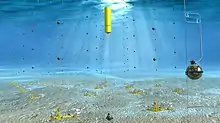
The Cubic Kilometre Neutrino Telescope, or KM3NeT, is a European research infrastructure located at the bottom of the Mediterranean Sea. It hosts the next-generation neutrino telescope with water Cherenkov detectors.
When completed, KM3NeT will have a total instrumented volume of several cubic kilometres distributed over three locations in the Mediterranean: KM3NeT-Fr (offshore Toulon, France), KM3NeT-It (offshore Portopalo di Capo Passero, Sicily, Italy) and KM3NeT-Gr (offshore Pylos, Peloponnese, Greece). The KM3NeT project continues the work done for the neutrino telescope ANTARES operated offshore the coast of France between 2008 and 2022.
Using KM3NeT, scientists search for neutrinos from distant astrophysical sources like supernova remnants, gamma-ray bursts, supernovae or colliding stars. The telescope is a powerful tool in the search for dark matter in the universe. Arrays of thousands of optical sensor modules detect the faint Cherenkov light in the deep sea from charged particles originating from collisions of the neutrinos and the water or rock in the vicinity of the detector. The position and direction of the optical modules and the time of arrival of the light on the photomultipliers inside is recorded with high precision. The trajectories of particles are reconstructed from these measurements. The research infrastructure also houses instrumentation for other sciences like marine biology, oceanography and geophysics for long-term and online monitoring of the deep-sea environment and the sea bottom at depths of several kilometres.
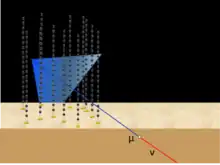
The KM3NeT 2.0 project is realising two large detectors, ARCA at KM3NeT-It and ORCA at KM3NeT-Fr. The ARCA detector is the cubic kilometre sized telescope searching for distant neutrino-sources. The ORCA detector is optimised for the measurement of the properties of the neutrino itself. In that sense, ORCA is a neutrino particle physics detector. Details can be found in the Letter of Intent.[1]
The oversight, governance and management of the implementation and operation of KM3NeT is conducted by an international collaboration. The KM3NeT community consists of about 250 scientists, along with engineers and technicians.
Design
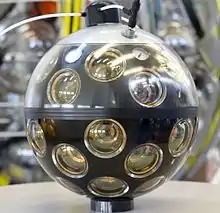
In the future and pending funding, the full neutrino telescope will contain in the order of 12000 pressure-resistant glass spheres attached to about 600 flexible vertical strings - or detection units - anchored at the seabed. At the end of the current phase of construction, the telescope will comprise 345 strings, 230 in the ARCA detector and 115 in the ORCA detector. The detection units support 18 spherical sensor modules each. The position of the modules and the time of arrival of light on the photomultipliers inside is measured with high precision. Each optical module is about 44 centimetres (17 in) in diameter, contains 31 three-inch photomultiplier tubes with supporting electronics, and is connected to shore via a high-bandwidth optical network.[2] Together, the ARCA and ORCA detectors contain 6210 optical modules. Via an electro-optical network of cables and subsea junction boxes the optical modules are connected to control stations on shore for electrical power, for detector control and for data transmission.[3]

Since the strings with optical modules move with the currents in the deep sea, the position and orientation of the optical modules and thus of the photomultoplier tubes inside is dynamically monitored using an acoustic system and a compass system, respectively.[4] Nanobeacons in each optical module are used for time calibration.[5]
At the shore of each KM3NeT installation site, a farm of computers performs the first data filter in the search for the signal of cosmic neutrinos, prior to streaming the data to a central KM3NeT data centre for storage and further analysis by the KM3NeT scientists.
The KM3NeT-It site, at a depth of 3400 m, hosts the ARCA (Astroparticle Research with Cosmics in the Abyss) detector, which with more widely spaced optical modules is optimised for the detection of high-energy cosmic neutrinos in the TeV–PeV range. Its strings are about 700 m long, spaced 90 m apart.
The KM3NeT-Fr site, at a depth of 2475 m, hosts the ORCA (Oscillation Research with Cosmics in the Abyss) detector, a more compact array with more closely spaced optical modules optimised for the detection of neutrinos in the GeV range. ORCA will consist of 115 strings in a 20 m triangular grid, with a 9 m spacing between the optical modules in a string. Overall, the array is about 210 m in diameter, and the strings are 200 m long.
Construction
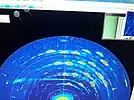
The design of the KM3NeT neutrino telescope is very modular and construction can be phased in time. In 2012, the first phase of the implementation of the KM3NeT research facility started with the construction of the seabed infrastructures at the KM3NeT-Fr and KM3NeT-It sites. A prototype KM3NeT optical module took data successfully during about a year in 2013-2014 part of the ANTARES telescope.[6] At the KM3NeT-It site a prototype string took data in 2014-2015, also during about one year.[7]
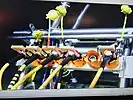
The first phase of construction has been successfully terminated. The second phase of construction has begun and comprises the completion of the ARCA and ORCA detectors at the KM3NeT-It and KM3NeT-Fr sites, respectively.
Relation to other neutrino telescopes
For the design of the neutrino detector, KM3NeT builds on the experience of the ANTARES telescope, which was operated from 30 May 2008 to the spring if 2022. It was the largest neutrino telescope in the Northern hemisphere. In the Southern hemisphere, at Antarctica, the IceCube Neutrino Observatory is already operational since many years. In Lake Baikal the Gigaton Volume neutrino Detector GVD is operated. Together, the three telescopes view the full sky.
Relation with the European institutions
As a unique experiment in Europe and thanks to the success of its predecessor ANTARES, KM3NeT has a special position within the European context. Throughout its history KM3NeT has received support from the European Union, via the participation in several European projects, but also thanks to the acknowledgement of the value of KM3NeT by the European institutions.
Indeed, in 2006 KM3NeT was included in the European Strategy Forum on Research Infrastructure (ESFRI) roadmap, which recognises as a priority the KM3NeT research infrastructure for Europe’s scientific needs for the next 10-20 years. The support was renewed by the Council of the European Union for the 2019-2026 period. While the first phase of the project led to the engineering of the modular detector and the construction of prototypes, the objective of KM3NeT 2.0 is to adapt to the scientific and technological progress made in the field of neutrino astroparticle physics. Therefore, the second inscription in the ESFRI roadmap reaffirms the interest of KM3NeT during its effective construction phase.
Along with the Council, the implementation of KM3NeT installation sites also benefitted from funding through the European Regional Development Fund (ERDF), confirming the economic, social and territorial potential of KM3NeT at regional level.
In addition, the experiment also benefited from different funding through European research and innovation programmes:
- From 2006 to 2009, the Design Study was supported by the European Sixth Framework Programme (EU FP6). The objective was to address the scientific and technical design issues related to the installation of the telescope.
- From 2008 to 2012, the Preparatory Phase for the KM3NeT infrastructure was funded by the European Seventh Framework Programme (EU FP7) in order to bring the telescope to its construction stage.
- From 2017 to 2020, KM3NeT benefited from the Horizon 2020 programme through the implementation of the KM3NeT-INFRADEV project, which objective was to support the development of the legal and governance aspects of the experiment, as well as to explore sustainable solution for the operation of the research infrastructure.
- From 2023 to 2026, these objectives are being taken up as part of the KM3NeT-INFRADEV2 project, funded by Horizon Europe, that should lead to the full implementation of the KM3NeT Research Infrastructure.
Finally, KM3NeT participated in many European projects, led by partners of the Collaboration. For example, KM3NeT takes part in the EMSO network, by providing long-term access for Earth and Sea sciences research. KM3NeT participated in the ASTERICS project,[8] and is still participating in the EOSC European initiative for Open Science as well as in the related ESCAPE project.[9] Last but not least, KM3NeT is also engaged in citizen science, notably through the REINFORCE project.[10]
These projects have received funding from the European Union programmes for Research and Innovation.
Image gallery
 Electronics to read out the photomultiplier tubes and calibration instrumentation inside the KM3NeT DOM
Electronics to read out the photomultiplier tubes and calibration instrumentation inside the KM3NeT DOM The KM3NeT LOM – the launching vehicle of Optical Modules – being loaded onto the RV Pelagia deployment vessel. A full string detection is rolled onto the LOM. After arrival at the seabed the string is unrolled to its full length.
The KM3NeT LOM – the launching vehicle of Optical Modules – being loaded onto the RV Pelagia deployment vessel. A full string detection is rolled onto the LOM. After arrival at the seabed the string is unrolled to its full length. A prototype KM3NeT DOM installed in the instrumentation line of the ANTARES neutrino telescope. The DOM is operational since April 2013.
A prototype KM3NeT DOM installed in the instrumentation line of the ANTARES neutrino telescope. The DOM is operational since April 2013. Artist's impression of the KM3NeT neutrino telescope.
Artist's impression of the KM3NeT neutrino telescope. KM3NeT optical modules attached with bollards to the supporting Dyneema ropes of a string.
KM3NeT optical modules attached with bollards to the supporting Dyneema ropes of a string.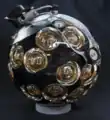 Imahe of a KM3NeT multi-PMT (31) optical module.
Imahe of a KM3NeT multi-PMT (31) optical module. Image of the KM3NeT LOM (Launcher of Optical Modules) with a string coiled in, on the ship's deck, prior to deployment.
Image of the KM3NeT LOM (Launcher of Optical Modules) with a string coiled in, on the ship's deck, prior to deployment. Top view of a KM3NeT LOM with a string coiled in.
Top view of a KM3NeT LOM with a string coiled in.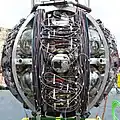 Image of the KM3NeT LOM with a string coiled in, waiting for shipment.
Image of the KM3NeT LOM with a string coiled in, waiting for shipment.
References
- ↑ The KM3NeT Collaboration (2016). "KM3NeT 2.0 – Letter of Intent for ARCA and ORCA". J. Phys. G: Nucl. Part. Phys. 43: 084001. arXiv:1601.07459. doi:10.1088/0954-3899/43/8/084001.
{{cite journal}}: CS1 maint: numeric names: authors list (link) - ↑ The KM3NeT Collaboration (2022). "The KM3NeT multi-PMT optical module". Journal of Instrumentation. 17 (7): P07038. arXiv:2203.10048. doi:10.1088/1748-0221/17/07/P07038.
{{cite journal}}: CS1 maint: numeric names: authors list (link) - ↑ The KM3NeT Collaboration (2023). "KM3NeT Broadcast Optical Data Transport System". Journal of Instrumentation. 18 (2): T02001. arXiv:2210.13328. doi:10.1088/1748-0221/18/02/T02001.
{{cite journal}}: CS1 maint: numeric names: authors list (link) - ↑ The KM3NeT Collaboration (2023). "Dynamical position and orientation calibration of the KM3NeT telescope". Proceedings of 38th International Cosmic Ray Conference — PoS(ICRC2023). p. 1033. doi:10.22323/1.444.1033.
{{cite book}}: CS1 maint: numeric names: authors list (link) - ↑ The KM3NeT Collaboration (2022). "Nanobeacon: A time calibration device for the KM3NeT neutrino telescope". Nuclear Instruments and Methods in Physics Research Section A. 1040: 167132. doi:10.1016/j.nima.2022.167132. hdl:10481/76880.
{{cite journal}}: CS1 maint: numeric names: authors list (link) - ↑ The KM3NeT Collaboration (2014). "Deep sea tests of a prototype of the KM3NeT digital optical module". Eur. Phys. J. C. 74 (9): 3056. arXiv:1405.0839. doi:10.1140/epjc/s10052-014-3056-3.
{{cite journal}}: CS1 maint: numeric names: authors list (link) - ↑ The KM3NeT Collaboration (2016). "The prototype detection unit of the KM3NeT detector". Eur. Phys. J. C. 76 (2): 54. arXiv:1510.01561. doi:10.1140/epjc/s10052-015-3868-9.
{{cite journal}}: CS1 maint: numeric names: authors list (link) - ↑ "ASTERICS project".
- ↑ "ESCAPE project".
- ↑ "REINFORCE project".
Further reading
- Adcock, C. (24 June 2016). "KM3NeT: The next big thing in neutrino physics". JPhys+.